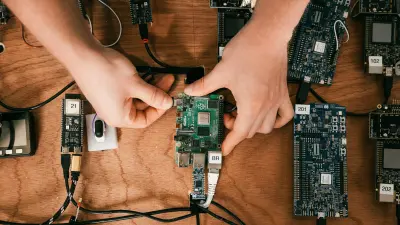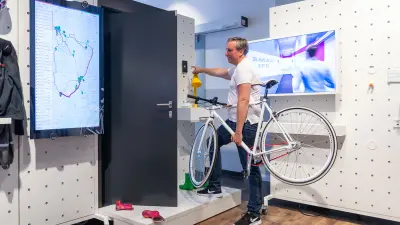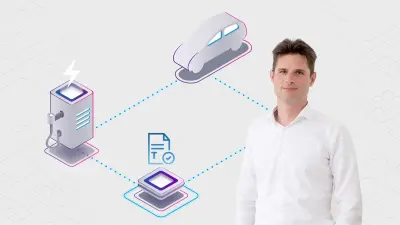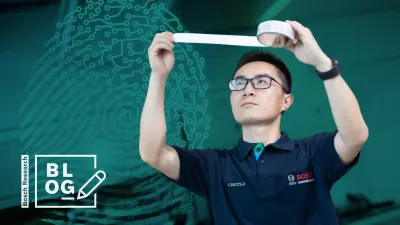Connected for life: People at the center of IoT solutions
Bosch Research is working on IoT ecosystems made up of connected solutions that are developed on the basis of a user-centric approach to unlock valuable potential for businesses and consumers alike.

Connected devices have become an indispensable part of everyday life. For many people, they make life easier and safer. With our research on IoT solutions, Bosch Research is focusing on people’s needs in the areas of living, working and mobility. This approach leads to intuitive, interactive and intelligent solutions that offer inspiring and seamless user experiences for Bosch products and services across multiple domains. For example, the experts at Bosch Research are helping the Bosch subsidiary BSH Hausgeräte GmbH with solutions for smart home applications as well as Bosch Home Comfort and Bosch Power Tools. Their work also helps other business units, e. g. in the mobility domain.
With our research on IoT we offer end-to-end connected systems that can be seamlessly integrated into various ecosystems. Our range of solutions includes sensors, devices, digital representations of things as well as knowledge-based and data-driven services. The more frequently products and solutions are used, the more data from the field are available to our development department and the more we can further improve and tailor these connected products in line with our customers' needs. The basis for this are the product usage data that are collected anonymously and securely by the connected devices. The aim here is to develop even better and more user-friendly products. To achieve this aim, Bosch Research intelligently evaluates and analyzes these data. Our vision is to help develop solutions that create added value for end consumers and generate new service business for Bosch.
ForeSight: A sustainable platform for smart living services

Smart living applications in residential settings offer users assistance, efficiency and comfort while ensuring data security and privacy. Bosch Research was part of the ForeSight project which was funded by the German Federal Ministry for Economic Affairs and Climate Protection and completed in the middle of 2023. It helped to create a sustainable platform for context-sensitive, intelligent and predictive services in the area of home and living. With ForeSight, the focus was on learning and understanding users’ behavior, routines and preferences, for example in the case of a cooking assistant in a smart connected kitchen. This knowledge is applied in a human digital twin to allow individual adaptation of smart living services. The human digital twin is a model of the user that depicts various characteristics that are relevant for the service. In the case of the cooking assistant, this means that the user's behavior can be used to model their cooking experience. This characteristic can then be an important input for the cooking assistant, which in the process — depending on the users’ experience — gives more detailed or less detailed step-by-step instructions or omits steps where appropriate.
Digital twin technologies can not only be applied to humans, but also to products, objects or environments. For example, we are developing digital twin solutions for construction sites where Bosch Power Tools are used. Based on innovative 3D room mapping data, these digital twins can provide real-time models of buildings to enable and automate tracking of construction progress.
Next step: The new “Matter” connectivity standard

Communication protocols that are compatible with products from a range of manufacturers and allow open ecosystems play a key role in user-centric connectivity solutions in the smart home. Bosch Research is working on such protocols, for example with the new “Matter” connectivity standard. The aim is to make new Bosch products “Matter-capable”. Matter and other new connectivity standards were developed by the Connectivity Standards Alliance (CSA). In the future, they will enhance market penetration and stimulate growth of smart homes and user-centric connectivity solutions. As a new, open smart home protocol, the Matter connectivity standard uses existing and familiar technologies such as Bluetooth Low Energy for device setup and Wi-Fi, Thread and Ethernet for connecting devices. Major smart home platforms and brands have already committed to upgrading their solutions such as existing hubs, smart speakers and other devices to the new connectivity standard. This will shift the focus from compatibility and fragmented ecosystems towards a positive user experience with a full range of customization options. Bosch Research is helping Bosch’s business units to develop innovative solutions which implement Matter in their products, e.g. by co-creating early proofs of concept. This demonstrates how communication between smart home devices works via the Matter communication protocol. In our Smart Life Lab in Renningen, we created a Matter test bed that allows developers across various business units to gain hands-on experience with Matter and dive into the details of the protocol.
Take a break in time: Detect fatigue with EEG

Intelligent connectivity also offers great potential at the interface to well-being, health and safety — for example in “brain-machine” applications such as a safety helmet with an integrated electroencephalogram (EEG) that Bosch Research is investigating. This detects whether, and to what extent, a wearer is tired. This is important on construction sites for example. If people work intensely over a long period of time, this can lead to mental fatigue. This results in reduced efficiency and safety risks. The safety helmet is able to detect fatigue in workers working at great heights and warn them in good time. Since the electroencephalogram records signals directly from the human brain, it can immediately detect changing levels of human fatigue. Based on EEG signals, Bosch Research is developing an independent and complete ecosystem for fatigue detection, including portable low-power signal acquisition devices and high-precision fatigue detection algorithms. The signal acquisition device collects the single-channel EEG signals on users’ foreheads, determines their fatigue level and transmits this information to the mobile terminal via Bluetooth. The fatigue detection algorithms are optimized on the basis of advanced artificial intelligence (AI). At the same time, data augmentation technologies are used to generate synthetic signals which significantly reduces the costs and time required to collect data and train the AI. The new safety helmet significantly improves the safety of workers on construction sites and at the same time implements a concept that focuses on people.

Conclusion
Connected digital solutions are changing the world we live in. In our research on IoT solutions, we combine sensor systems, communication technologies and advanced AI methods relating to Bosch products. We always focus on users in order to create real added value for them.

